Abstract
The aim of this study was to establish the relative importance of risk factors for mortality after acute upper gastrointestinal haemorrhage, and to formulate a simple numerical scoring system that categorizes patients by risk. A prospective, unselected, multicentre, population based study was undertaken using standardised questionnaires in two phases one year apart. A total of 4185 cases of acute upper gastrointestinal haemorrhage over the age of 16 identified over a four month period in 1993 and 1625 cases identified subsequently over a three month period in 1994 were included in the study. It was found that age, shock, comorbidity, diagnosis, major stigmata of recent haemorrhage, and rebleeding are all independent predictors of mortality when assessed using multiple logistic regression. A numerical score using these parameters has been developed that closely follows the predictions generated by logistical regression equations. Haemoglobin, sex, presentation (other than shock), and drug therapy (non-steroidal anti-inflammatory drugs and anticoagulants) are not represented in the final model. When tested for general applicability in a second population, the scoring system was found to reproducibly predict mortality in each risk category. In conclusion, a simple numerical score can be used to categorize patients presenting with acute upper gastrointestinal haemorrhage by risk of death. This score can be used to determine case mix when comparing outcomes in audit and research and to calculate risk standardised mortality. In addition, this risk score can identify 15% of all cases with acute upper gastrointestinal haemorrhage at the time of presentation and 26% of cases after endoscopy who are at low risk of rebleeding and negligible risk of death and who might therefore be considered for early discharge or outpatient treatment with consequent resource savings.
Full text
PDF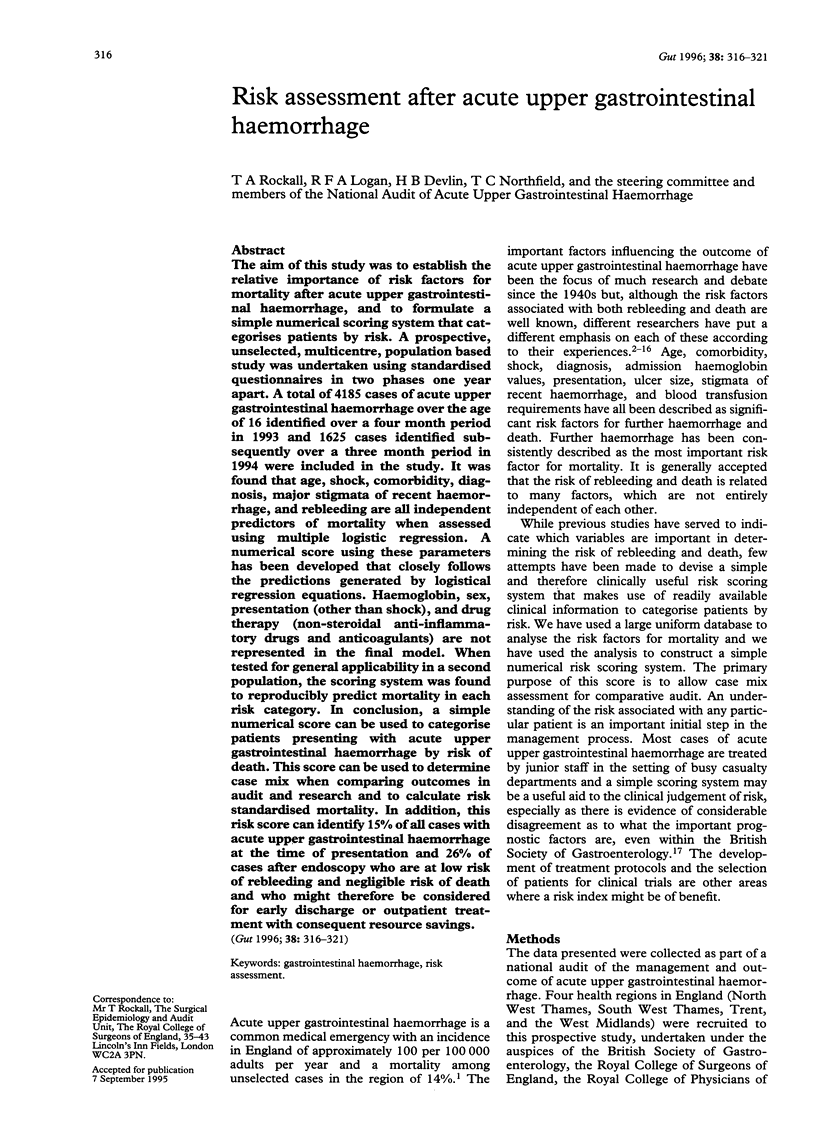
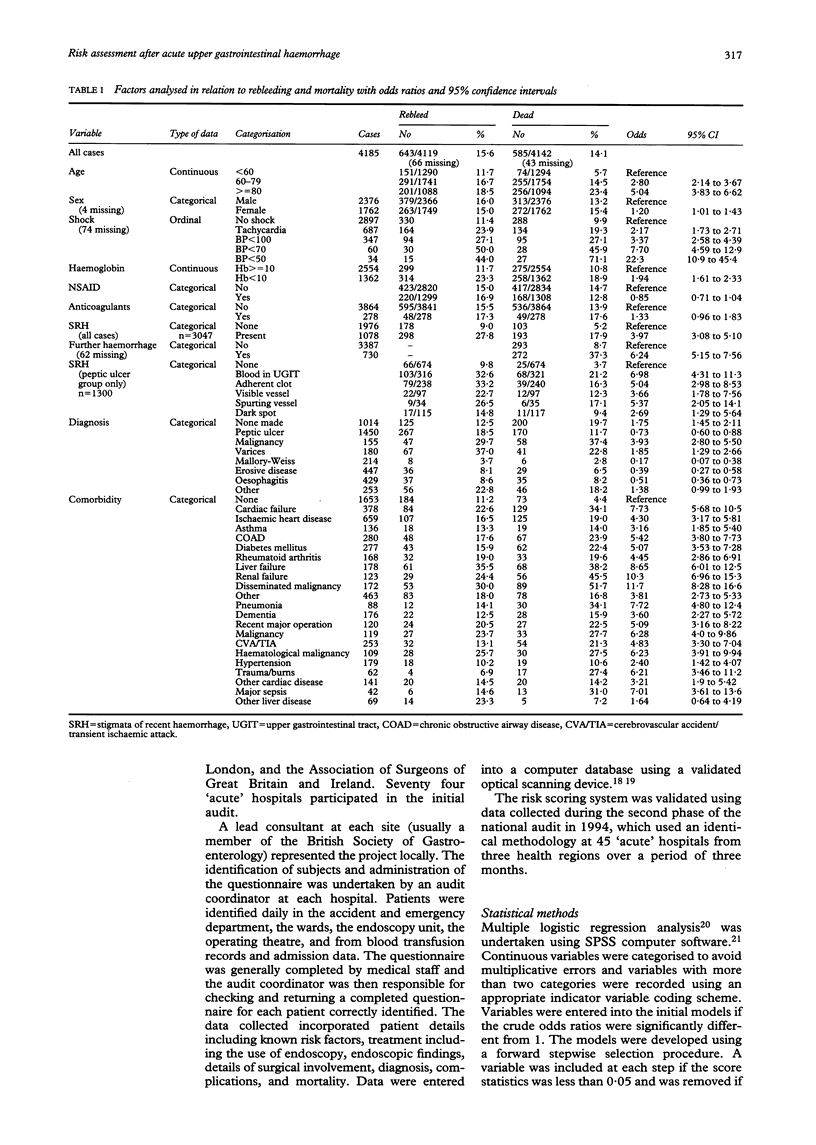
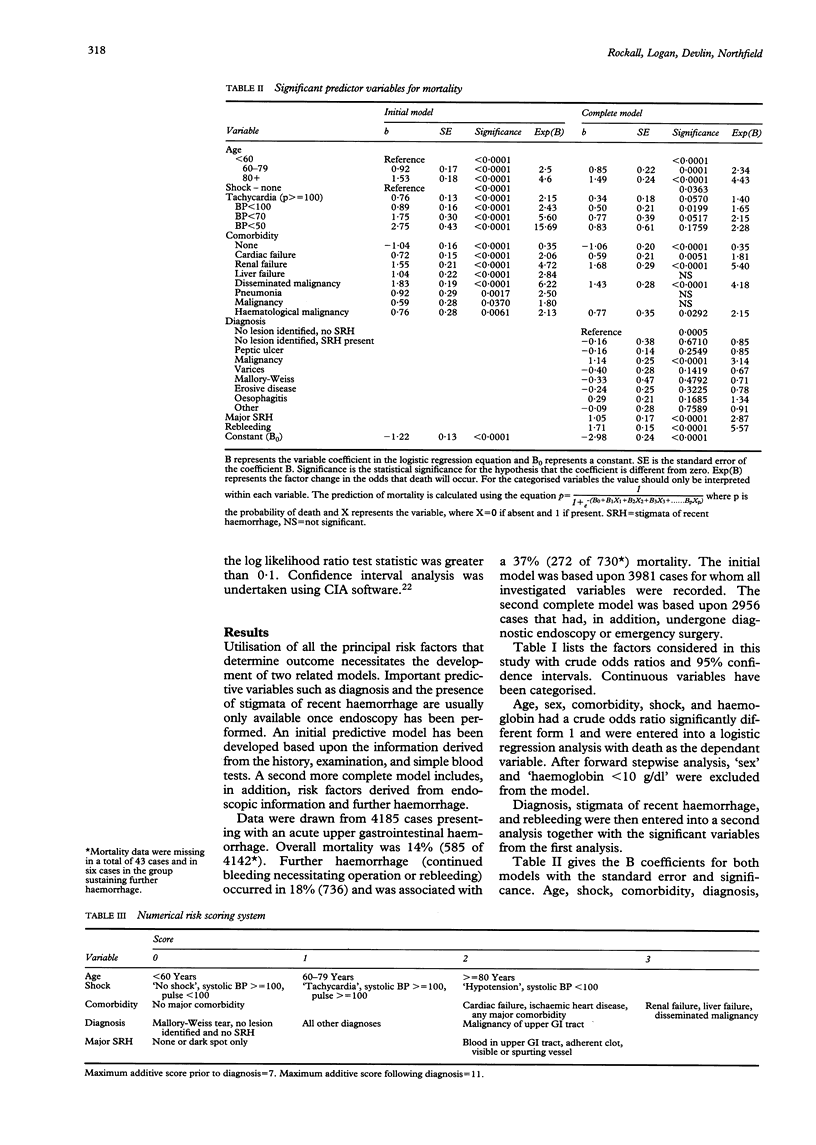
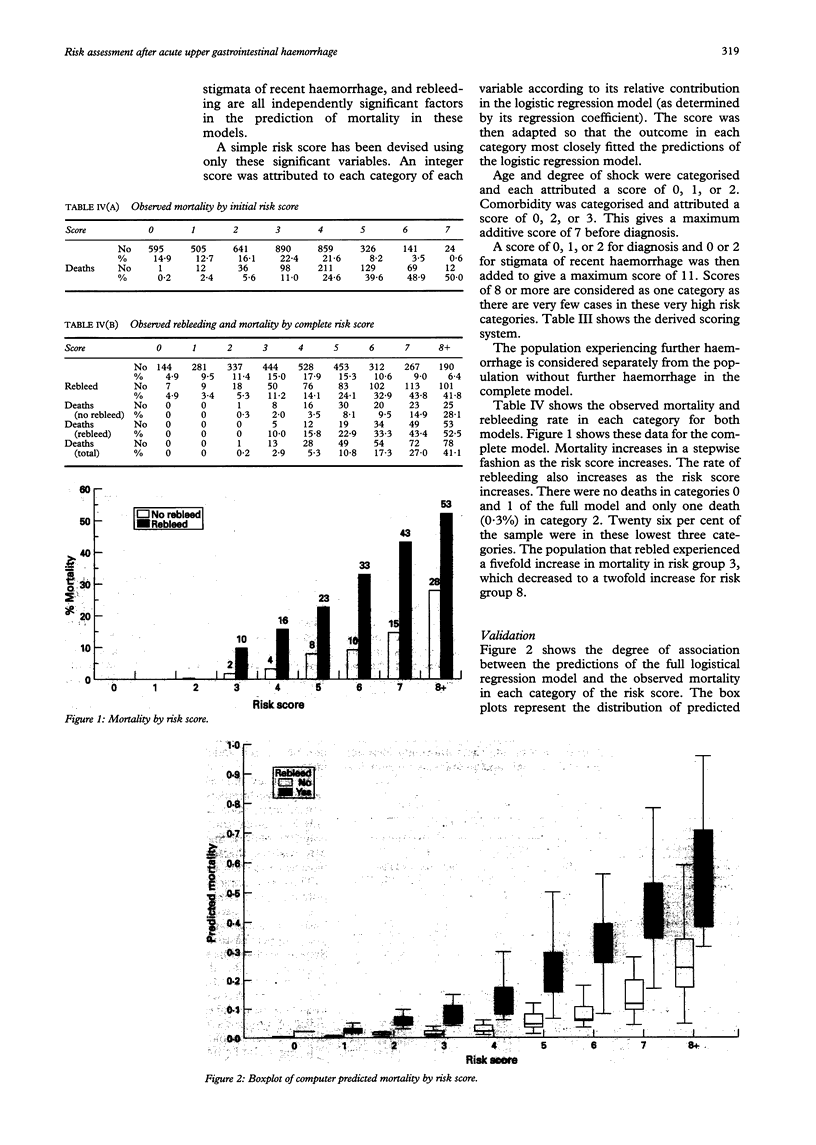
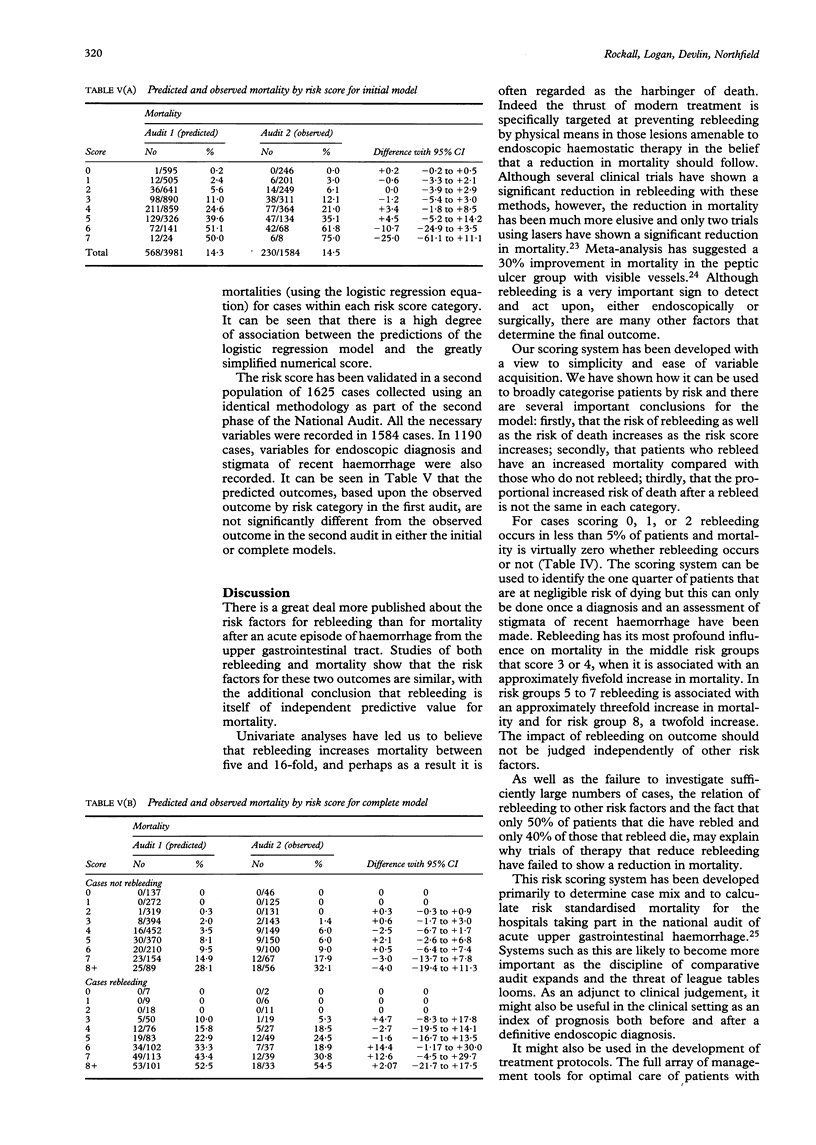
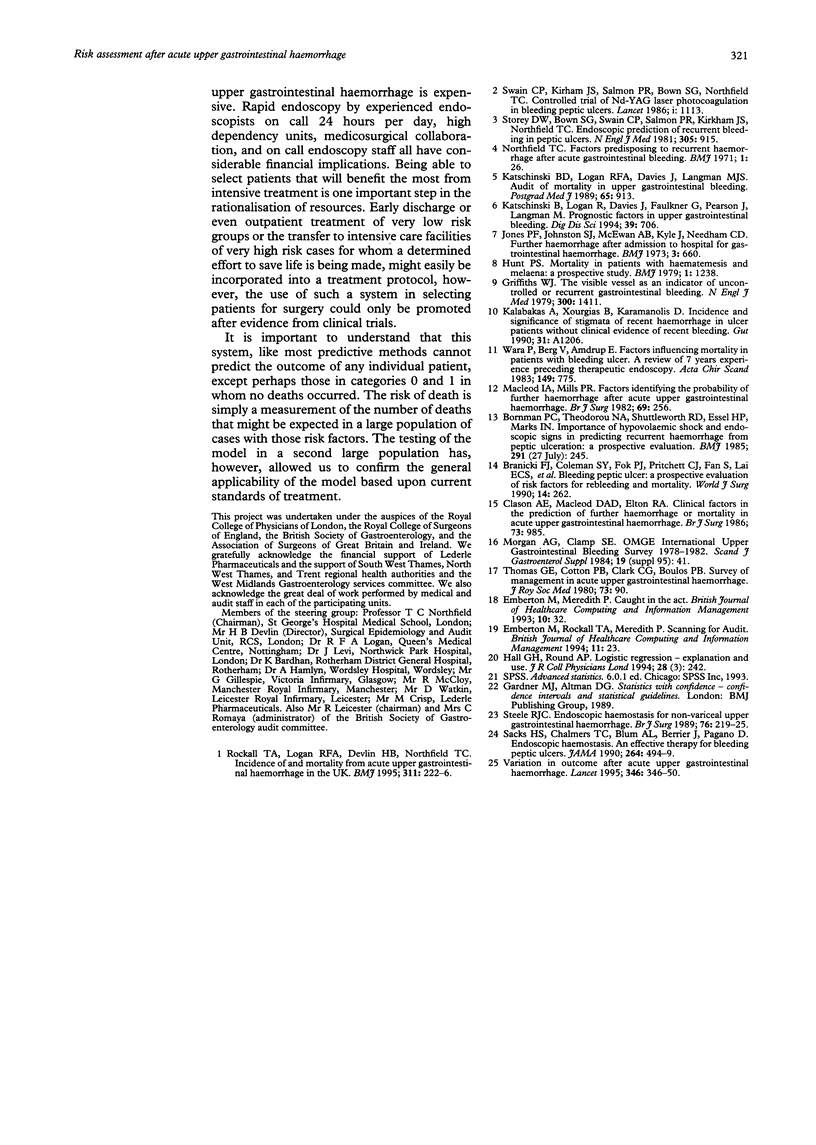
Selected References
These references are in PubMed. This may not be the complete list of references from this article.
- Bornman P. C., Theodorou N. A., Shuttleworth R. D., Essel H. P., Marks I. N. Importance of hypovolaemic shock and endoscopic signs in predicting recurrent haemorrhage from peptic ulceration: a prospective evaluation. Br Med J (Clin Res Ed) 1985 Jul 27;291(6490):245–247. doi: 10.1136/bmj.291.6490.245. [DOI] [PMC free article] [PubMed] [Google Scholar]
- Branicki F. J., Coleman S. Y., Fok P. J., Pritchett C. J., Fan S. T., Lai E. C., Mok F. P., Cheung W. L., Lau P. W., Tuen H. H. Bleeding peptic ulcer: a prospective evaluation of risk factors for rebleeding and mortality. World J Surg. 1990 Mar-Apr;14(2):262–270. doi: 10.1007/BF01664889. [DOI] [PubMed] [Google Scholar]
- Clason A. E., Macleod D. A., Elton R. A. Clinical factors in the prediction of further haemorrhage or mortality in acute upper gastrointestinal haemorrhage. Br J Surg. 1986 Dec;73(12):985–987. doi: 10.1002/bjs.1800731213. [DOI] [PubMed] [Google Scholar]
- Griffiths W. J., Neumann D. A., Welsh J. D. The visible vessel as an indicator of uncontrolled or recurrent gastrointestinal hemorrhage. N Engl J Med. 1979 Jun 21;300(25):1411–1413. doi: 10.1056/NEJM197906213002503. [DOI] [PubMed] [Google Scholar]
- Hall G. H., Round A. P. Logistic regression--explanation and use. J R Coll Physicians Lond. 1994 May-Jun;28(3):242–246. [PMC free article] [PubMed] [Google Scholar]
- Hunt P. S., Hansky J., Korman M. G. Mortality in patients with haematemesis and melaena: a prospective study. Br Med J. 1979 May 12;1(6173):1238–1240. doi: 10.1136/bmj.1.6173.1238. [DOI] [PMC free article] [PubMed] [Google Scholar]
- Jones P. F., Johnston S. J., McEwan A. B., Kyle J., Needham C. D. Further haemorrhage after admission to hospital for gastrointestinal haemorrhage. Br Med J. 1973 Sep 29;3(5882):660–664. doi: 10.1136/bmj.3.5882.660. [DOI] [PMC free article] [PubMed] [Google Scholar]
- Katschinski B. D., Logan R. F., Davies J., Langman M. J. Audit of mortality in upper gastrointestinal bleeding. Postgrad Med J. 1989 Dec;65(770):913–917. doi: 10.1136/pgmj.65.770.913. [DOI] [PMC free article] [PubMed] [Google Scholar]
- Katschinski B., Logan R., Davies J., Faulkner G., Pearson J., Langman M. Prognostic factors in upper gastrointestinal bleeding. Dig Dis Sci. 1994 Apr;39(4):706–712. doi: 10.1007/BF02087411. [DOI] [PubMed] [Google Scholar]
- MacLeod I. A., Mills P. R. Factors identifying the probability of further haemorrhage after acute upper gastrointestinal haemorrhage. Br J Surg. 1982 May;69(5):256–258. doi: 10.1002/bjs.1800690509. [DOI] [PubMed] [Google Scholar]
- Rockall T. A., Logan R. F., Devlin H. B., Northfield T. C. Incidence of and mortality from acute upper gastrointestinal haemorrhage in the United Kingdom. Steering Committee and members of the National Audit of Acute Upper Gastrointestinal Haemorrhage. BMJ. 1995 Jul 22;311(6999):222–226. doi: 10.1136/bmj.311.6999.222. [DOI] [PMC free article] [PubMed] [Google Scholar]
- Sacks H. S., Chalmers T. C., Blum A. L., Berrier J., Pagano D. Endoscopic hemostasis. An effective therapy for bleeding peptic ulcers. JAMA. 1990 Jul 25;264(4):494–499. doi: 10.1001/jama.264.4.494. [DOI] [PubMed] [Google Scholar]
- Steele R. J. Endoscopic haemostasis for non-variceal upper gastrointestinal haemorrhage. Br J Surg. 1989 Mar;76(3):219–225. doi: 10.1002/bjs.1800760305. [DOI] [PubMed] [Google Scholar]
- Storey D. W., Bown S. G., Swain C. P., Salmon P. R., Kirkham J. S., Northfield T. C. Endoscopic prediction of recurrent bleeding in peptic ulcers. N Engl J Med. 1981 Oct 15;305(16):915–916. doi: 10.1056/NEJM198110153051603. [DOI] [PubMed] [Google Scholar]
- Swain C. P., Kirkham J. S., Salmon P. R., Bown S. G., Northfield T. C. Controlled trial of Nd-YAG laser photocoagulation in bleeding peptic ulcers. Lancet. 1986 May 17;1(8490):1113–1117. doi: 10.1016/s0140-6736(86)91835-0. [DOI] [PubMed] [Google Scholar]
- Wara P., Berg V., Amdrup E. Factors influencing mortality in patients with bleeding ulcer. Review of 7 years' experience preceding therapeutic endoscopy. Acta Chir Scand. 1983;149(8):775–785. [PubMed] [Google Scholar]


